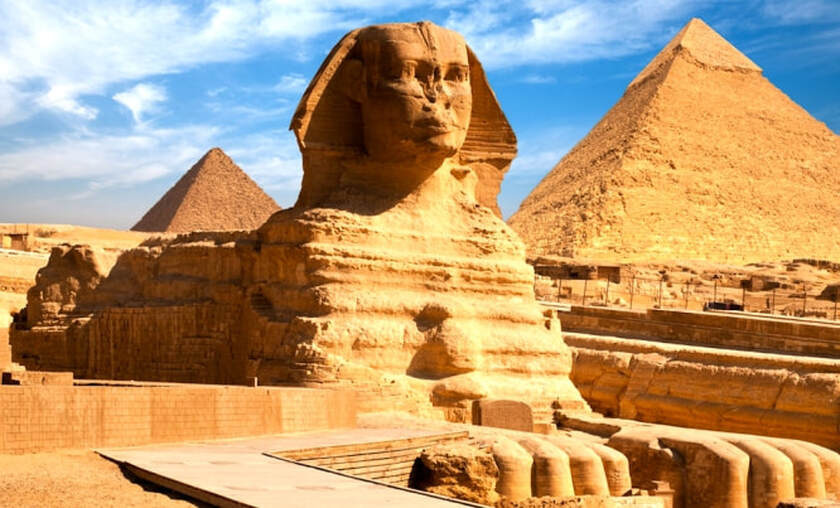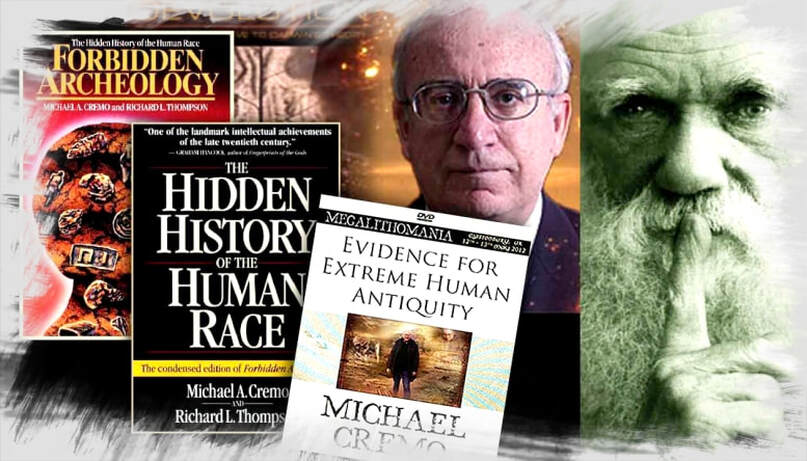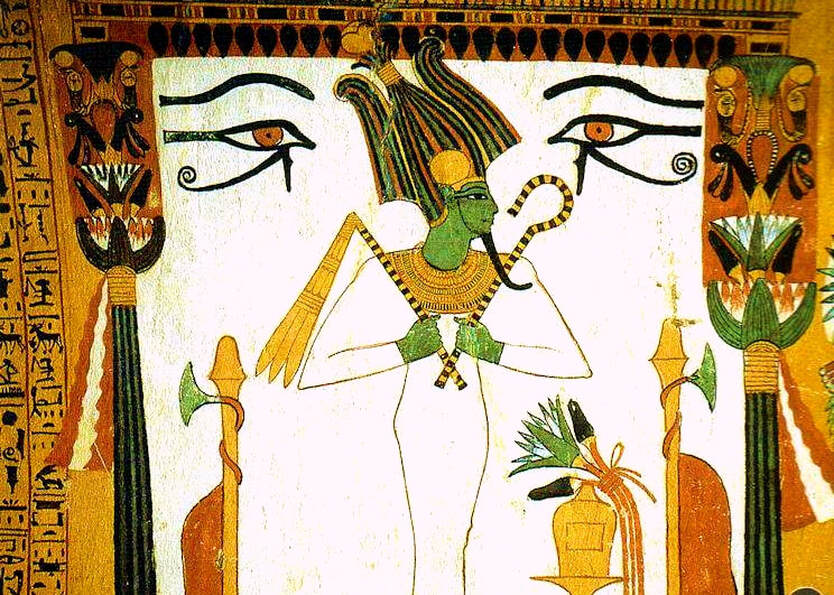A GOD IN RUINS
by Michael Tsarion
Man is a god in ruins – R. W. Emerson
A few of the world’s greatest thinkers refuted the common notion of ancient primitivism. They understood that prehistoric man was not the bestial creature beloved of historians and history books.
Social critics such as William Blake, Julius Evola, Schwaller de Lubicz, Rudolf Steiner, Helena Blavatsky, and others, seriously doubted the historical record, pointing to structures such as the Great Pyramid in Egypt as evidence of high prehistoric civilizations. Given that structures of similar majesty exist the world over – and that there is no record of the antecedent stages of development essential for them – we are right and rational to doubt inadequate conventional attitudes about the past.
Schwaller set out to solve the riddle. The outcome was his masterwork, The Temple of Man (1957), demonstrating that the Luxor temple is of immense geometrical complexity, and that it is a symbolic representation of a man – a kind of gigantic hieroglyph…One of Schwaller’s main insights was that the temple also contains many examples of the geometrical proportion known as the ‘Golden Section’ (and called by the Greek letter phi)…and it also plays a central part in the precise location of sacred sites – Colin Wilson (The Atlantis Blueprint)
…the Great Pyramid revealed an extraordinary knowledge of mathematics and geography. Its four sides are aligned exactly to the four points of the compass, and its site is exactly 30 degrees north of the equator – precisely one-third of the distance from the equator to the pole. Evidence that the Egyptians knew the length of the equator and its distance from the poles and that the Pyramid itself is intended to represent half of the earth, from the equator to the North pole, indicates that the Egyptians of 2,500 BC had knowledge of worldwide geography – ibid
Most people simply accept official accounts of humanity’s past without question. If it’s in the history books and encyclopedias, and if most archaeologists and anthropologists teach it, why should I think differently and rock the boat?
It takes a while to realize that the “experts” have it all wrong, from top to bottom, and have many subversive reasons for propagating historical disinformation. It doesn’t take much for the average accredited scholar to fall in line with his peers and stick to the favored narrative. In fact, he’s is royally compensated for doing so. He doesn’t want to be penalized, spurned and impoverished by the system for speaking out against mainstream narratives.
The good news is that certain men and women have spoken out, and were not intimidated by the corrupt academic system. Men such as L. A. Waddell, Comyns Beaumont, John Allegro and Barry Fell were outspokenly critical of the official record, particularly in terms of religion. Their ideas on the origins of Judaism and Christianity, etc, were highly controversial, fascinating and revolutionary. Their ideas are still academically taboo.
What must happen is for each person to ask themselves why we are inclined to believe that men of prehistory were primitive. Does it make any sense at all to believe it? What if the opposite is true? After all didn’t Plato himself hold that many ancient civilizations had existed before his time, and that they were sophisticated and advanced?
There have been a thousand holocausts, which have occurred in a thousand ways and will recur, both by fire and by water and by many other means – (Priests of Egypt to Solon, father of Plato)
It’s wrong to expect the whole world to radically change its view of antiquity, no matter how many spunky revisionists appear from time to time. Whereas in previous years dissenting voices were summarily silenced, it’s no longer as easy to quell dissent.
Also as more archeological sites are excavated, findings continue to vex experts and contradict the official narrative. The cat was set among the pigeons in the 1940s after the discovery of the Dead Sea Scrolls and Nag Hammadi Library. The clutch of biblical experts in charge of their collation and decipherment had the devil of a time keeping the lid on the controversial material, even though their campaign of deception persisted for over forty years.
A few years ago a massively funded National Geographic exploration of the underwater shelves and coastlines of Britain and Ireland confirmed once and for all the theory of catastrophism not uniformitarianism, the official paradigm. Why has this monumental discovery had zero effect in schools and colleges where kids are still taught falsities about the earth?
Despite widespread academic chicanery, it’s imperative that we become familiar with the controversial theories of eminent independent scholars such as L. A. Waddell, John Allegro, Barry Fell, Thomas L. Thompson, Niels Peter Lemche, Michael Cremo, Charles Hapgood, and others of their sort. A great deal depends on it.
But the question remains, what kind of men were the ancients? Were they rude and bestial? Were they chronically insecure and fearful? Did they cower when thunder shook the skies? Did they think lightning was caused by the wrath of the gods? Did they think of floods, disease and enemies as responses to their disobedience toward the gods? A reading of the Hebrew Bible certainly gives that impression.
On the condition of early man, historian Mircea Eliade tells us:
It is from this original and originating experience – feeling oneself “thrown” into the middle of an apparently limitless, unknown and threatening extension – the different methods of orientation are developed; for it is impossible to survive for any length of time in the vertigo brought on by disorientation – (A History of Religious Ideas, Vol. 1)
Eliade addresses the common notion that early man lived in sheer terror of existence, but fails to question where we get this unfalsifiable idea. Might not a psychologist say it’s a case of projection? Is it not a case of temporal fallacy and modern bias, by which we arrogantly and falsely construe the character and lifestyle of the ancients?
After all, what does it signify if indeed our forebears were riddled with fear about life? What does it tell us about their consciousness? And, more importantly, what evidence is there to refute this outlook? Might not it have been a simple case of rational fear in the face of objective threats to their safety, as we experience today?
Apologists for the official view remind us that there was a lot to be fearful about in ancient times, and we’re not just talking bad weather. The constant threat of fearsome wild animals prevented feelings of security for early tribespeople. Threat of attack by all sorts of predators preoccupied them, and a great deal of time was spent being on guard against it, especially during the night. There were no romantic strolls through the forests for these folks.
The reality of daily combat with deadly animals led to all sorts of rites and customs in which animal-spirits were placated and venerated. Tribal chiefs more a lion’s tail as part of their kingly regalia and hung leopard pelts over their doors to signify status. Pharaohs made a point of displaying personal prowess through ritualistic lion hunts, and many a shaman took to wearing skins and horns to display their “animal” knowledge, connection with nature and conquest over the so-called spirit world.
So yes, there was a lot to fear. No one doubts that. But what we blithely refer to as “fear,” could also be more correctly described as awe, wonder and reverence. I suppose we haven’t bothered considering the difference between “reverent fear” and other cruder forms and instances of the emotion.
In any case, we cannot discount the fact that ancient man was in many ways more rational and sophisticated than moderns generally accept. Again, we need only cite the existence of the Great Pyramid. Where did it come from? Who erected it and how?
One doesn’t need to look far to find convincing evidence of prehistoric superiority. Skeptics simply cannot account for the mathematical and geometric sophistication of the earth’s many cyclopean structures. Who erected them, and how and why were they built? Each structure’s existence challenges and dismisses the arguments of hardline skeptics unwilling to grant the ancients any kind of prowess.
Christopher P. Dunn, the British toolmaker and engineer already mentioned, has examined the Great Pyramid from the engineering point of view. His study led him to conclude…that the Egyptian pyramids and temples ‘reveal glimpses of a civilization that was technically more advanced than is generally believed’ – Colin Wilson
Schwaller de Lubicz had argued in his “Sacred Science,” that it seemed to prove that the ancient Egyptians knew about the precession of the equinoxes in the Age of Taurus, more than 6,000 years ago – ibid
Clearly, early man’s fear didn’t prevent him excelling in cyclopean architecture and being a mathematical genius.
Structures such as the Great Pyramid, Stonehenge and Avebury, etc, ensure that we never wholly accept the contemptuously limited view about prehistoric man and his abilities. There’s obviously more to it. A monkey may at some point learn how to use a tool, but isn’t likely to learn how to make one from scratch, not on any sophisticated level.
If a man decides to erect a massive pyramid with 2.5 million blocks of stone – which no modern crane can budge – he’s obviously not doing it for mere decorative purposes. He may, in fact, be honoring his race or ancestors. He may be intent on preserving the memory of a great king, or may be venerating a deity. Guess what? He may even be showcasing an idea. What does that do for our low assessment of his character and consciousness?
Again, if ancient man created complex symbolic languages – barely decipherable by modern experts – he must have done so for a reason.
In other words, although it is clear that ancient man feared certain phenomena, he did so rationally. This is because his understanding of reality was also rational. Which means he was a rational being. If it were otherwise, we’d not have the incomparably brilliant philosophies of Lao Tzu, Heraclitus, Democritus, Plato and Aristotle, etc.
In fact, even before the Athenian sages, we have the wisdom of the Egyptians, Babylonians and Persians. Where did it come from? Why did ancient man develop technical skill and philosophical insight, and was he nothing more than a brutish “primitive” before doing so?
Clearly, our assessments are mostly based on non-objective criteria. We judge early man based on modern achievement. However, as several thinkers have shown, it’s not a particularly strong position, given that we aren’t as advanced as we stubbornly and arrogantly believe.
I would sooner take instruction from the builders of the temple of Luxor, than from the creators of napalm – John Anthony West
A few scholars hold that all the physical and intellectual marvels of early man were relatively minor compared to what existed before their time. They came to this conclusion because it’s what most indigenous tribes themselves believe and claim.
Spokesmen from many tribes repeatedly tell of ancient civilizations of great eminence. Instead of “great men theory,” they have “great races theory,” insisting that the noblest people existed in a period known as the “golden age.” It was these beings who were truly “civilized.”
Prominent Vedic scholars and Brahmin priests in India have expounded the same ideas for centuries. For instance, in the ancient Puranas we read the following:
All kings occupying the earth in the Kali Age will be wanting in tranquility, strong in anger, taking pleasure at all times in lying and dishonesty, inflicting death on women, children and cows, prone to take the paltry possessions of others, with character that is mostly tamas, rising to power and soon falling. They will be short-lived, ambitious, of little virtue and greedy. People will follow the customs of others and be adulterated with them; peculiar, undisciplined barbarians will be vigorously supported by rulers. Because they go on living with perversion, they will be ruined. And Dharma becomes very weak in the Kali age, and people commit sin in mind, speech, and actions…Quarrels, plague, fatal diseases, famines, drought, and calamities appear. Testimonies and proofs have no certainty. There is no criterion left when the Kali age settles down. People become poorer in vigor and luster. They are wicked, full of anger, sinful, false, and avaricious. Bad ambitions, bad education, bad dealings, and bad earnings excite fear. The whole batch becomes greedy and untruthful. Many sudras (low castes) will become kings, and many heretics will be seen…There will arise various sects; sannyasins (holy men) wearing clothes colored red. Many profess to have supreme knowledge because, thereby, they will easily earn their livelihood. In the Kali age, there will be many false religionists. India will become desolate by repeated calamities, short lives, and various diseases. Everyone will be miserable owing to the dominance of vice and Tamoguna; people will freely commit abortion…Earth will be valued only for her mineral treasures. Money alone will confer nobility. Power will be the sole definition of virtue. Pleasure will be the only reason for marriage. Lust will be the only reason for womanhood. Falsehood will win out in disputes. Being dry of water will be the only definition of land. Praise worthiness will be measured by accumulated wealth. Impropriety will be considered good conduct, and only feebleness will be the reason for unemployment. Boldness and arrogance will be equivalent to scholarship. Only those without wealth will show honesty. Just a bath will amount to purification, and charity will be the only virtue. Abduction will be marriage. Simply to be well dressed will signify propriety…And any hard-to-reach water will be deemed a pilgrimage site. The pretense of greatness will be the proof of it, and powerful men with many severe faults will rule over all the classes on earth. Oppressed by their excessively greedy rulers, people will hide in valleys between mountains, where they will gather honey, vegetables, roots, fruits, birds, flowers and so forth. Suffering from cold, wind, heat and rain, they will put on clothes made of tree bark and leaves. And no one will live as long as twenty-three years…Thus in the Kali Age humankind will be utterly destroyed.
– (Translation from Sanskrit by Cornelia Dimmit)
In the extraordinary Kalki Prophecy of ancient India, the present age is known as the “Age of Filth.” Ancient Vedic texts refer to it as the blackened “Kal Age” of iron and tears, a time of moral inversion, hedonism and utter corruption.
From early Irish mythology, we read:
I shall not see a world,
Which will be dear to me:
Summer without blossoms,
Cattle will be without milk,
Women without modesty,
Men without valor.
Conquests without a king,
Woods without mast,
Sea without produce.
False judgements of old men,
False precedents of lawyers,
Every man a betrayer,
Every son a raider.
The son will go to the bed of his father,
The father will go to the bed of his son.
Each his brother’s brother-in-law.
He will not seek any woman outside his house.
An evil time.
Son will deceive his father,
Daughter will deceive.
– The Morrigu’s Prophecy
A very early Irish lamentation, dating from before the arrival of the Celts and Gaels, reads:
Then she added a prophecy in which she foretold the approaching end of the divine age, and the beginning of a new one in which summers would be flowerless and cows milkless and women shameless and men strengthless, in which there would be trees without fruit and seas without fish, when old men would give false judgments and legislators make unjust laws, when warriors would betray one another, and men would be thieves, and there would be no more virtue left in the world.
– Prophecy of Queen Badb (Bave)
Similar refrains are found in the Norse Edda and Voluspa, and in Finnish texts. For example, the Norse concept of Ragnarok, the “decline of the gods,” has destruction and apocalypse as central themes. In the Voluspa we read:
Brothers will fight and kill each other,
Sisters’ children will defile kinship.
It is harsh in the world,
Whoredom is rife.
An axe age, a sword age,
Shields are riven.
A wind age, a wolf age,
Before the world goes headlong.
No man will have mercy on another.
Mircea Eliade tells us:
…in the last period of paganism the Germans were extremely concerned with eschatology. The end of the world was made an integral part of their cosmogony – (History of Religious Ideas, Vol. 2)
The most complete and dramatic description is supplied by the poem Voluspa…The well-known cliches of all apocalyptic literature make their appearance: morality declines and disappears, men kill one another, the earth trembles, the sun grows dark, the stars fall; freed from their chains, the monsters descend on the earth; the Great Snake emerges from the Ocean, bringing on catastrophic inundations…finally the whole earth is swallowed by the Ocean, and the sky crumbles – ibid
Prophecies of the Cherokee and Apache Indians specifically reference the degeneration of humankind and apocalypse that inevitably destroys future civilizations. Given these dire refrains and predictions, we see why certain later thinkers were not eager to laud the modern world.
Julius Evola, Schwaller de Lubicz and Rudolf Steiner were among those original thinkers who did not accept that our ancient forebears were fear-ridden primitives.
Man is perfect at his origin, a divine being who has degenerated into what we are – Schwaller de Lubicz
Skeptics usually explain the golden age theory away. As far as they are concerned it’s a matter of magical or animistic thinking, without credibility or substance. Others reduce it to a case of envy on the part of backward tribespeople in the face of overwhelming modern progress and plenty. For them the mentality is: Sure, you whites are full of yourselves and boastful about your achievements, but in ancient times our forefathers were way ahead of you.
The problem with this dismissal is that white races also speak of prehistoric marvels. Nordic and Finnish texts and folklore allude to primordial high civilizations, even speaking of a so-called “Arctic Homeland” (Ultima Thule) referred to by the ancient Greeks as Hyperborea – the extreme northern paradise.
Some skeptics conceive of it as an epiphenomenon of one’s personal craving to return to the womb. However, since this is physically impossible, the human mind conjures the phantasmagoria of a “surrogate womb,” which can or will be accessed. This takes the form of a utopian future civilization, thought to be a reproduction of a vastly ancient golden age of the gods, when peace and harmony reigned supreme. Even the Platonists held that the earlier the epoch, the more sophisticated and tranquil the civilization. It’s an intriguing theory.
In any case, those tribes preserving details of a prehistoric paradisal age regard themselves as lesser in terms of intellect and creativity, viewing their own cultures as relatively inferior to those of bygone epochs. Despite modern marvels, members of these tribes refuse to change their attitude about this, maintaining that today’s human being is an inferior specimen to that which existed in the idyllic past. This premise has been taken seriously by a few open-minded scholars.
Helena Blavatsky (1831-1891) was a Russian mystic who developed a convoluted but intriguing theory about the devolution of spirit. In her opinion modern races are descended from at least seven “root races.” (Here for more…)
One of these open-minded scholars was the eminent Scottish engineer Alexander Thom (1894-1985). Working from within the “system,” he discovered evidence that ran contrary to officially held ideas about the construction of ancient megalithic sites. The skills used in their construction were extremely advanced and their measurements uncannily precise.
Prof. Thom discovered that many perfectly placed stones aligned with constellations, stars and luminaries, and that the mathematics employed in the various stone circles was more precise and perfect in Britain and Ireland. The standard of measure got less and less accurate as one moved eastward across Europe.
Crucially, Prof. Thom noted that since the stone circles and other sites in the west were of an earlier date than those in the east, the art and science of megalithic construction must have began in the west and later moved to the east, transported by those with less time, skill and care. He speculated that the font of mathematical prowess was in the prehistoric west, and offered substantial proof to back his controversial theory. Of course, he and his astonishing findings were summarily ignored.
It follows that when marvelously accurate structures are found in eastern lands – such as the Great Pyramid and Baalbek Stone – it is quite logical to suppose they were built by the apprentices of globe-trotting sages from the west, known universally as the Arya. Sadly, this proposition is still unacceptable to most academics, compromising the lies they’ve swallowed for so long.
It is remarkable that 1000 years before the earliest mathematicians of classical Greece, people in these islands (the British Isles) not only had a practical knowledge of geometry and were capable of setting out elaborate geometrical designs but could also set out ellipses based on Pythagorean triangles – Prof. Alexander Thom (Megalithic Sites in Britain, 1968)
The builders of the Stone Age monuments of the British Isles used a unit of length that was defined to one ten-thousandth of a millimeter. That unit is fundamental to the Sun, Moon and Earth – Butler & Knight (Civilization One)
Was there a super-advanced culture in prehistory? If not, how can it be that the supposedly unsophisticated people of Stone Age Britain possessed a fully-integrated system of measurement based on a deep understanding of the solar system? – ibid
This west to east migration of the elements of civilization – particularly in regards mathematics, astronomy and megalithic construction – has been completely verified by the research of Ralph Ellis.
Recently, engineer Scott Onstott has categorically proven that many columns, obelisks, statues, cathedrals, and civic buildings throughout the world – dating to relatively recent times – have been purposely aligned not only to heavenly bodies, but one to another. The elaborate geometrical networks he has discovered are based on dimensions and numbers considered sacred by the ancients.
The writers John Michell, Gerald Hawkins, Henry Lincoln, David Wood, Alan Butler, William Dafoe, Stephen Knight, Ralph Ellis, and others, have analyzed man-made structures all over the world which are likewise aligned to each other or to planets, stars, sunrises, sunsets, lunar phases, eclipses and so on. Since mathematical skills of this highly advanced kind must have developed over long expanses of time, we are forced to realize that early man’s capabilities long preceded the evidence we see in stone. The starting point of this vast process can’t even be guessed.
…prehistoric man already behaved in the manner of a being endowed with intelligence and imagination – Mircea Eliade
Anthropologist Michael Cremo raises the important question of human devolution in his books and talks. He has also found evidence of sophisticated human civilizations dating back millions of years. (Here for more…)
So is it all simply a matter of infantile thinking and wish-fulfillment? Most believe so, and most intellectuals – who on the surface accept the complexity of structures such as the Great Pyramid and Baalbek Stone, etc – give the matter little thought. We conclude that it is their fear we’re dealing with.
Their thinking runs along these lines: Just as a fanciful girl may daydream about her “true” parents being royalty, soon to return and claim her, so too can a whole tribe or society fancifully feel that their ancestors were veritable gods.
Of course, the problem with these rationalizations is that they can all be wrong. Blake, Steiner, Blavatsky, de Lubicz, d’Olivet, Evola, Spengler, Tilak, Donnelly, and others, might be right. After all, might not spiritual declination precipitate historical decline? Might not a spiritual sleep have fallen upon us, preventing us recognizing our previous majesty?
Why could the soul not have devolved from higher to lower states? Under the technological facade, are we moderns really that advanced? Many may not be inclined to agree. And what if it is finally proven that our ancestors were more sophisticated and skillful than us? What will that do for our image of ourselves and our future potential?
However, even without all the highfalutin theories about the preeminence of the ancients, we need only ask ourselves whether our current relationship with nature and animals is wholesome and just. For all our technical capability, are our grotesque cities and institutions conducive to life?
Maybe it is by way of massive acts of dissociation and self-deception that we fix a temporal divide between ourselves and the ancients. Maybe the belief in superior ancestors isn’t due to infantile hankering, but to a deeper rational need to reclaim the past in a healthy way. Maybe it’s the result of our subconscious recognition that something is lost to us, something mighty and wondrous, and perhaps this longing is spiritual in nature, as Blake and Blavatsky believed. For all our technical prowess and expertize in so many fields, we know inwardly that we’re fatally emotionally and spiritually impoverished.
Take herbalism for example. We find that the ancients – be they Celts, Tibetans or Native American Indians – were exceptionally knowledgeable in this field. Their proficiency with medicinal plants had to be the result of the meticulous observation and testing of nature over millennia.
Take physical health and the weakness of our immune system for example. Why all the illnesses, diseases and infirmities? Why so many constitutional ailments, disturbances, pathogens and cancers? Is it all a sign of a weakened degenerated soul?
Is the dreadful phenomenon of human devolution revealed by humankind’s immunal weakness and susceptibility to numerous illnesses?
Take astronomy as another example. As the eminent astronomer Jean Sylvain Bailly discovered, some enormously lengthy astronomical cycles, known to the ancients and recorded by them, can only be seen and measured from lands on the forty fifth latitude of the earth. This in turn means that a single homogeneous community of expert stargazers had to occupy a specific region in Europe or the Near East for at least 100,000 years.
We’re talking a school of astronomers whose data on the movement of the stars was meticulously preserved from time immemorial. Given that it takes millennia to slowly develop this level of sophistication, we see that thousands of years elapsed before history acknowledged the existence of such a community.
This strongly corroborates the statements of numerous native societies insisting that the ancients were godlike beings possessed of vast knowledge.
Toward the close of the eighteenth century the celebrated astronomer, Bailly, published a work entitled “The History of Ancient Astronomy,” in which he endeavored to prove that a nation possessed of profound wisdom and great genius, and of an antiquity far superior to the Hindus or Egyptians, “inhabited the country to the north of India, or about fifty degrees north latitude.” This writer has shown that “the most celebrated astronomical observations and inventions, from their peculiar character, could have taken place only in these latitudes” – Godfrey Higgins (Celtic Druids)
But this is not the only anomaly upsetting the apple-cart. Add to it the existence in Peru of the Nazca Lines, visible only from the air. Add the extraordinary vases of feldspar and quartz which simply could not be shaped and hollowed out without unbelievably sharp tools and immense heat. What about the antiquity of hieroglyphics and alphabets, and the numerous weighty sarcophagi in Egypt and Malta that cannot be reproduced today. Top engineers can’t explain how they were carved out, or what kind of tools were used.
The Baalbek Stone and others found in the Great Pyramid cannot be lifted by any modern crane. The huge slabs of red granite under the Sphinx were brought to the Giza Plateau from hundreds of miles away. No one can explain how they were cut, transported and laid in place. And what of the evidence in Egypt of iron smelting at temperatures exceeding 1,000 degrees Celsius? What of the complex mining operations in Africa known to have gone on 100,000 years ago? What about the cave art from 90,000 years ago, so beautifully and precisely drawn as to be still be discernible and evocative today? What about the tools found in Ethiopia, dating to 175,000 years ago? What about the mortar found between blocks in ancient temples, dating back 200,000 years? What about the ocher found in temple paintings dating back 300,000 years? What about the antiquity and astronomical precision of the Mayan Tzolkin calendar? What of the atomic theories expounded in the Vedas, thought to date back to at least 2,000 years BC? And what about the piece of woven cloth found inside a nugget of amber dating back 25 million years? On and on go the examples.
…the “First Time” constitutes the Golden Age of absolute perfection, “before anger, or noise, or conflict, or disorder made their appearance.” Neither death nor disease were known during this marvelous period, called “the time of Ra.” At a certain moment, as a result of the intrusion of evil, disorder appeared, putting an end to the Golden Age – Mircea Eliade
Central to all magical techniques was the invocation of the First Time. By the First Time the Egyptians meant the nontemporal realm in which archetypal events enacted by the gods take place – Jeremy Naydler (Temple of the Cosmos)
Speaking of antiquity, it is possible that certain mythical deities – Cernunnos, Osiris, Ptah, Gilgamesh, Hephaestus, Hermes, Dionysus, Prometheus, etc – represent the ancient past and painstaking accumulation of a race’s skill and wisdom. Certain holy and exalted ones may typify the “godlike” abilities of the ancients, personifying the lost state of consciousness from which later humanity descended. They may represent mysterious beings or archons who transmitted “divine” powers to humanity
…no idea is as absurd as the idea of progress – Julius Evola
Evola believed that humanity is not the result of the “ascent of man” from mammals, but of a separate origin better called a “descent”…and the summit from which humanity has degenerated…was destroyed in a catastrophe, probably due to a change in the inclination of the earth’s axis – Jocelyn Godwin
Devolution theorists are of the opinion that the scientific skill evident in today’s world is but a remnant of much earlier expertize. Those tribes and races we deem primitive are, as most of them assert, descended from highly advanced predecessors whose relationship with time, cosmos and being was far beyond our understanding.
These mysterious forebears had a far more sensitive and wholesome connection with the cosmos than any modern man can possibly comprehend and attain. For example, the Irish Druids refused to cut any living plant with a sharp blade. They had no concept of nature as “lower” or debased, and it was forbidden to teach children and give instruction while indoors. Their grove-schools had no ceilings and rooves.
One of the main reasons why moderns resist the concept of devolution, and have entrained one another to see only evidence for “evolution” is because of the fear which arises if the former theory is taken seriously.
If an immensely long process of spiritual, moral and technological declination is occurring, the outlook for the future isn’t good. It means that the process continues despite what one thinks and does. It’s a process sure to continue until the doomsday point arrives.
This means that the human race is terminal. As William Blake warned, there is indeed a point of no return for humanity, and we’re very close to it. Some say we’re already far beyond it, and that the last great “high” for humanity will be its own inevitable cataclysmic obliteration.
Many things are known to the wise. They foresee many things; the decline of the world and the end of the Aesir – (The Voluspa)
. . .






















